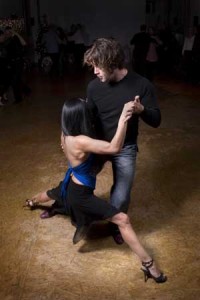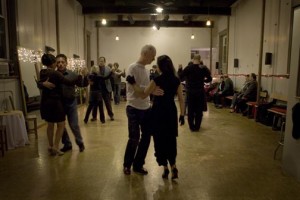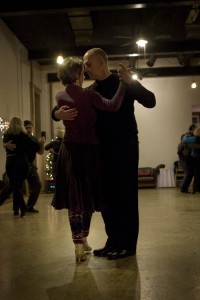Tango!
Posted on January 1, 2010 – 10:53 PM | by OldManFosterBy Jackson Griffith Photos by Jesse Vasquez
Like some exotic hothouse flower transplanted to Sacramento, a city that likes to venerate the far more mundane camellia, the Argentine dance called tango has taken hold, and seems to be flourishing here.
It is a cold Tuesday night in late autumn Downtown, at an old firehouse on 9th Street on the alley below T Street. A sign over the entry reads “Lee On Dong,” which leads one to believe it may house one of the middle-kingdom family associations whose many clubhouses seem to dot the old Chinese neighborhood. But that merely signifies there’s a group of Mah Jongg gamers that meets upstairs; the first floor houses a dance studio.
 Inside the door, the atmosphere warms and thickens. Eight couples circle the oblong wooden floor in the proscribed counter-clockwise direction, while a five-piece band – a loose amalgamation calling itself the Fire Ants, under the direction of Dan Printz, one of the dance studio’s three partners – churns out a local interpretation of the music played by the orquestras tipica in Argentina, where tango came into existence toward the end of the 19th century.
Inside the door, the atmosphere warms and thickens. Eight couples circle the oblong wooden floor in the proscribed counter-clockwise direction, while a five-piece band – a loose amalgamation calling itself the Fire Ants, under the direction of Dan Printz, one of the dance studio’s three partners – churns out a local interpretation of the music played by the orquestras tipica in Argentina, where tango came into existence toward the end of the 19th century.
On this night the group, which only plays the Tuesday night practicas once a month (on the other practice nights an iPod playlist of tango classics serenades the dancers), features a violinist, a cellist, a European-style button accordionist who doubles on upright piano, a standup bassist, and Printz on guitar. The notes emanating from the band swirl around the dancers like wisps of ground fog, the sharp melodic turns and brittle chromatic flavorings nipping at active feet, inciting them to keep moving. The music’s heady mix of South American spicing, hemmed in by the formal strictures appropriated from the European classical tradition, pushes forward in a cycle of build and release, with a palpable sense of tension that could resolve with either pots boiling over and knifeblades flashing in the kitchen, or else a passionate ruffle between the sheets in the bedroom. But there is an overarching scaffold of civility that seems to hold everything in check.
The dancers circle the room, gliding at a leisurely ramble to cues from the music. For tango is all about the stroll, and it moves along at an andante pace, despite any underlying tension. “They say that in tango, one is always learning how to walk,” says Sriram Eleswarapu, a recent transplant from Houston who has only been dancing for 11 months. “Because the walk is different from your typical walking down the street; you have to ground yourself, and it’s a really esoteric concept that comes after months of practice – the way you push off the ground.”
Eleswarapu, like other tangueros and tangueras – male and female tango dancers – got pulled in by the seductions of tango, which differs from other dancing styles in the way its participants interact on the dance floor. Like other forms of close-contact dancing, there is a leader and a follower; typically a man for the former and a woman for the latter. There are essentially three forms of embrace: close or chest-to-chest, open, and half-open or joined at one side.
 However, in tango, the signals between the dancers are more subtle than overt; there’s almost a Taoist flow of energy wherein the roles of leader and follower blur, like the creative and the receptive intermingle in the yin-yang symbol of the Tao. Part of that difference may come from the lead dancer directing via movement from the chest. “Look at Joe there,” Eleswarapu says, motioning toward the floor. “He’s not leading with his arms. What he’s doing is he’s turning around his own axis; he keeps a very straight posture at midline and rotates around that axis. There’s not a whole lot of manhandling – which differentiates it from swing, or salsa, where it’s all in the arms or wrists.”
However, in tango, the signals between the dancers are more subtle than overt; there’s almost a Taoist flow of energy wherein the roles of leader and follower blur, like the creative and the receptive intermingle in the yin-yang symbol of the Tao. Part of that difference may come from the lead dancer directing via movement from the chest. “Look at Joe there,” Eleswarapu says, motioning toward the floor. “He’s not leading with his arms. What he’s doing is he’s turning around his own axis; he keeps a very straight posture at midline and rotates around that axis. There’s not a whole lot of manhandling – which differentiates it from swing, or salsa, where it’s all in the arms or wrists.”
So tango is the chess of social-dance culture, with a sizable intellectual component at work. These are not the so-called guidos and guidettes of the MTV reality series Jersey Shore, “beating up the beat” with liquored-up fist pumps. Instead, there’s a turn-of-the-last-century, almost courtly consideration apparent, which can be observed via the ritual of the cabeceo: When a tanguero wishes to invite a tanguera to dance, it’s done nonverbally, with eye movements and nods of the head, often from across a crowded room. There’s no obvious embarrassment of rejection, should the tanguera choose to direct her gaze elsewhere.
This contextual formality of tango makes it a safe haven for strangers who crave the intimacy of close physical contact, and would like to feel comfortable expressing a public face of the sexiness they feel internally, but don’t want to go through the rigamarole of boorish pickup lines – or worse. Which gives it a certain appeal to some adults with a low tolerance for meat-market behavior, especially women.
“I can count maybe one or two men, in all the years I’ve been tango-ing, who made me feel icky,” says Evie, a petite blonde woman whose tango affinities have driven her to seek the dance out wherever she travels. “Those people do not last; that just does not happen. And if it does, there are other people who will step in and run them off. I’ve actually heard of the men approaching such a guy, as a group, and saying, ‘Knock it off.’ So it is a context where I feel safe. It’s nice.”
On this night, the practica is being guided by Michelle Gorre, who, with her teaching partner Chris Peake, runs the Tango Alternativa group at Firehouse 5. She echoes that sentiment. “You can get in each other’s personal space, you can get very intimate with somebody, but it’s non-threatening,” she says. “There’s an underlying feeling of respect that Argentine tango brings out in everybody.”
 Like virtually everyone else who confesses a serious tango addiction, Gorre stumbled into it by accident, in her case signing up for a salsa dancing class in Auburn, where she was living 10 years ago. When the instructor switched the course to tango, she went along – and got hooked.
Like virtually everyone else who confesses a serious tango addiction, Gorre stumbled into it by accident, in her case signing up for a salsa dancing class in Auburn, where she was living 10 years ago. When the instructor switched the course to tango, she went along – and got hooked.
What attracted her initially was tango’s cerebral nature. “It wasn’t just a frivolous and brainless dance,” she says. “You actually had to be present, and connected with your partner. It was difficult and challenging, and the same time was emotional and sensual.”
What pulled Gorre in was a balance she felt between freedom and restraint in the dance form, followed by a sense of community and family among the people obsessed with it. “People come to tango for many reasons,” she says. “They come for companionship, to learn how to dance, to find the love of their life.”
And what they find often turns out to be quite different than what got them through the door, a self-contained universe where, as Gorre puts it, they can connect with each other, with the music, with the room. “It’s a beautiful thing,” she says.
Downtown offers a couple of consistent options for tango dancers. Tango by the River meets in Old Sacramento at 128 J Street. Founded by Donna Williams seven years ago, it is the older of the two tango groups, and more closely adheres to a traditionalist Argentine tango aesthetic, hosting milongas (dances) the second and fourth Saturday of each month. That studio also offers classes several times a week, private lessons, and a Thursday night practica.
Tango Alternativa has been meeting at the Firehouse 5 Dance Studio at 2014-B 9th Street for the past two years, hosting milongas the first and third (and fifth) Saturday each month, along with dance classes and a Tuesday night practica. As its name indicates, the group is less yoked to traditional tango, and more open to nuevo tango and other alternative forms of the dance.
In addition, there’s the omnibus website (www.sactango.com) where information on tango activities are happening in the greater Sacramento area.
Tags: Chris Peake, Jackson Griffith, Michelle Gorre, Sacramento, Tango, Tango Alternativa, Tango by the River


